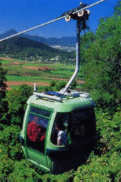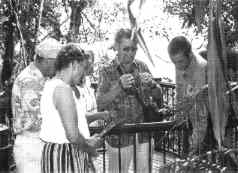
The CRC for Tropical Rainforest Ecology and Management
Educating visitors:
What are the benefits for tourism? Gone are the days when tour operators simply loaded and unloaded passengers. Today's increasingly demanding and experienced clientele require more unique experiences and opportunities for self development. Education services for visitors, otherwise known as "interpretation", may play an important role in ensuring tourism operations meet visitor expectations. But is there any evidence that interpretation can make a substantial contribution to tourist satisfaction and improving sustainability?
The Skyrail Rainforest Cableway in Cairns provided an opportunity for us to examine these questions. 
The Skyrail Rainforest Cableway takes visitors on a gondola trip above the canopy of the rainforest. The 7.5 km aerial journey is the longest gondola cableway in the world and a major tourism draw card for the Cairns region. Skyrail did not want to simply provide a gondola ride, but a rainforest experience with interpretation as a central component. From this experience, Skyrail hoped to be able to increase visitors' understanding of the rainforest and encourage conservation in this area. To aid this, Skyrail developed three main interpretive facilities: an interpretive boardwalk, an interpretive centre; and personal interpretation from guides on the walks and lookouts.
The study
Surveys were conducted with English speaking Skyrail visitors in 1996 to find out if visitors were more satisfied with the Skyrail experience because of the interpretation offered. Part of the study questioned whether the visitors were learning about the rainforest by using the range of interpretive materials available.
In order to compare changes in knowledge and satisfaction levels, samples of visitors were surveyed both before and after their Skyrail trip. Of the respondents, 80 per cent were independent visitors, and 20 percent were part of a tour group. Also, 89 per cent were first time Skyrail visitors, with 11 per cent having taken the trip before. The total sample size was 276 pre-trip and 369 post-trip surveys.
Visitor's impressions
Visitors' satisfaction with their Skyrail trip was high. The average score for overall satisfaction was 8.7 using a scale of 1 (not at all satisfied) to 10 (extremely satisfied). Ratings on individual components, such as service, value for money, efficiency of the staff, friendliness of the staff, and information on the rainforest were similarly high. These high satisfaction scores were supported by the fact that the majority of visitors intended to visit Skyrail sometime in the future. In addition, a high 92 percent would definitely recommend Skyrail to others.
Overall, these results indicate that visitors enjoyed their Skyrail experience. But does interpretation have any influence on satisfaction, or would visitors be just as satisfied with the gondola ride alone? From a tourism perspective, is there actually any point in providing visitors with a learning experience? Is interpretation worth the effort?
In the case of Skyrail, interpretation does influence satisfaction. Skyrail visitors who go on the interpretive boardwalk, go into the interpretive centre, and/or talk to a ranger were significantly more satisfied than those who do not. For Skyrail, interpretation makes good business sense because it creates a more positive experience for its visitors. Do visitors learn anything?
In addition to considering whether interpretation was valuable to a tourist attraction, the project also considered whether the tourist attraction was effective at interpretation. Results have shown that visitors enjoy Skyrail and are satisfied with their experience. Does the educational component add depth to their experience?
Results indicated considerable differences in learning between respondents belonging to a tour group and those travelling independently. Tour group respondents showed no
 significant differences in rainforest knowledge between visitors surveyed prior to their Skyrail trip and those surveyed after. However, this group were also significantly less likely to experience any of the interpretation on offer at Skyrail. It is likely that tight time schedules mean that tour group members do not experience the interpretation, and thus do not learn a great deal. significant differences in rainforest knowledge between visitors surveyed prior to their Skyrail trip and those surveyed after. However, this group were also significantly less likely to experience any of the interpretation on offer at Skyrail. It is likely that tight time schedules mean that tour group members do not experience the interpretation, and thus do not learn a great deal.
An Interpretive ranger at the Skyrail boardwalk
takes the time to point out rainforest plants
to Skyrail visitors.
For independent visitors, the results were more positive. After visiting Skyrail these visitors had significant increases in: - how much they felt they knew about the rainforest
- curiosity about the rainforest
- a correct score for a set of true/false general knowledge questions about the rainforest.
Comparison of visitors with different levels of exposure to the interpretation on offer demonstrated that the more interpretation experienced by visitors, the more they learn. Interpretation is good for tourism and tourism is good for interpretation
This study provides a useful example of how tourism and interpretation can form a symbiotic relationship. In this case, interpretation was good for tourism and tourism was good for learning.
Interpretation provided depth to the visitors' experience, helping to achieve high levels of satisfaction. Such an influence is good for business, as satisfied customers will tell their friends and be repeat visitors. Indeed, the results demonstrated that visitors' "intention to return" and tendency to recommend Skyrail to others provide support for this conclusion. But perhaps more importantly, tourism was shown to be good for learning.
Skyrail provides the opportunity for large numbers of tourists of every nationality, interest and ability, to access a valuable and important environment. Not only are these visitors able to access the rainforest, but Skyrail had succeeded in encouraging a sense of inquiry and in helping visitors actually learn something about the environment.
For more information about this study, please contact:
Dr Gianna Moscardo
Ms Barbara Woods
Department of Tourism
James Cook University of North Queensland
Townsville Qld 4811
Tel: (07) 47814254
Fax: (07) 47814019 The CRC for Tropical Rainforest Ecology and Management is a formal partnership between the CSIRO, James Cook University of North Queensland, The University of Queensland, Griffith University and the Wet Tropics Management Authority.
P 0 Box 6811 Cairns Qld 4870 tel: (07) 4042 1246 fax : (07) 4042 1247 Web site: http://www.crctrem.edu.au Providing science for the conservation and management of Australia's World Heritage tropical rainforests. 
|
